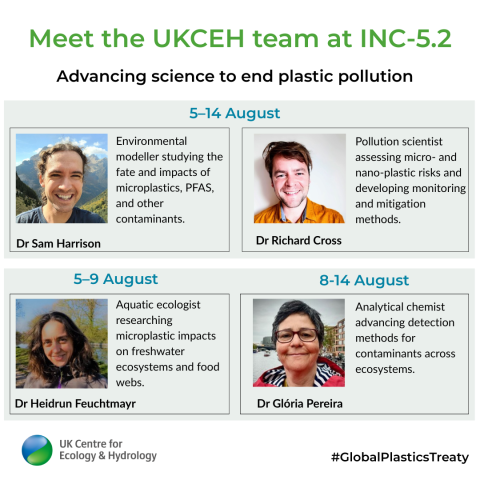The sixth and final session of the Intergovernmental Negotiating Committee (INC-5.2) for the Global Plastics Treaty takes place from 5 - 14 August 2025 in Geneva. The goal: a legally binding global agreement to end plastic pollution. With negotiations at a critical stage, UKCEH scientists are attending as official Observers to ensure science and evidence guide decision-making.
Key negotiation points
- Should the treaty include a cap on plastic production—and what defines a sustainable level?
- Will it address the full life cycle of plastics?
- How will it regulate additives and other chemicals of concern?
Plastic pollution has already breached planetary boundaries and worsens other global crises, including climate change, ocean acidification, and biodiversity loss.
The UKCEH delegation comprises:
- Dr Sam Harrison
Environmental modeller studying the fate and impacts of microplastics, PFAS, and other contaminants. - Dr Richard Cross
Pollution scientist assessing micro- and nano-plastic risks and developing monitoring and mitigation methods. - Dr Heidrun Feuchtmayr
Aquatic ecologist researching microplastic impacts on freshwater ecosystems and food webs. - Dr Glória Pereira
Analytical chemist advancing detection methods for contaminants across ecosystems

UKCEH scientific priorities at INC-5.2
- Chemical additives must be included
Plastics contain tens of thousands of chemicals. These co-occur in the environment and can concentrate during recycling, posing risks to human and environmental health. - Plastic emissions are greater to soils and surface waters than oceans.
Plastic emissions are greater to soils and surface waters than to oceans. Tyre wear contributes to high micro- and nano-plastic levels in roadside soils, while wastewater treatment transfers plastics to farmland via biosolids. - Monitoring is essential for Treaty success
While litter monitoring is established, micro- and nano-plastics are under-monitored. As larger plastics degrade, smaller particles will become more prevalent. Baseline monitoring is essential to track trends and measure treaty progress. - Safe environmental levels are likely to be exceeded
Evidence shows plastics harm plants, animals, and humans. Over 1,500 species ingest microplastics, and exposure is linked to tissue damage in wildlife. Due to plastic's persistence, safe levels will almost certainly be exceeded in the future. - Waste management alone is not enough
Achieving 2010 emission levels would require over 99% waste management efficiency. Reducing primary plastic production through legally binding targets is more effective and essential.
Key references
Billings et al (2023), Billings et al (2025), Nava et al (2023), Horton et al (2021), Defra (2025), Pfohl et al (2025).
Recent blog posts and projects
Upstream project for waste free European rivers
FRAGMENT-MNP Project
Microplastics in freshwater
New detection methods for toxic tyre wear chemicals
